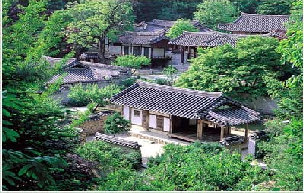Byeongsan Seowon (Confucian School) - Built in 1563
Byeongsan Seowon is a Confucian School established by esteemed Confucian scholars to pay tribute to the memory of Seong-nyong Yu (1542-1607), a much revered author and personality of that time.
This Confucian School was one of the 47 places in Korea and one of the two places in Andong which were not destroyed during the rule of Daewongun in 1868. It was established in 1563 near the village of Pungsanhyeon and given the name Pungak Seodang.

There were difficulties with the site and the academy was shifted to Andong and its name changed to Byeongsan Seowon, which means "Academy of the Mountains Folding Screens". This relocation took place in the fifth year of the reign of King Seonjo (1572) by Ryu Seongrong with the purpose to train disciples.
In 1614, Confucian scholars put up a memorial tablet to Ryu to immortalize his scholastic achievements and knowledge making this a famous Seowon of all times.
Like most institutions, this Confucian School was established by local scholars and supported by sympathetic members of the local community.
The Seowon was largely autonomous from the government and around the time of 1863, Confucian schools enjoyed many freedoms under the Joseon rule, students and scholars of the school were free from taxation, conscription, labor duties and other expenses.
The academy prospered in its early years and was enlarged in 1614 during the sixth year of King Gwanghaegun (1608-1623) when a shrine was added to memorialize Yu Seongnyong (1542-1607), an exemplary scholar-official. Thus initiated the tradition at private academies of enshrining departed Confucian scholars whose lives were worthy of emulation.
The Nakdong-gang River is situated just in front of the Confucian school. If you cross the river, you will see the Byeongsan Mountain. By forming a folding screen-like shape around the school, these mountains protect and enhance the beauty of the area.
Byeongsan Seowon Back to Historic Sites





